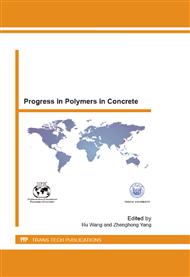p.443
p.449
p.456
p.461
p.466
p.472
p.480
p.485
p.490
Influence of Polymer and Fiber on the Properties of Special Plaster Mortar for Aerated Concrete
Abstract:
As a new self-Insulation wall material, the autoclaved aerated concrete block has many advantages such as lightweight, thermal insulation, waste recycling, low energy consumption, friendly to environment, etc. It is gaining favors in the construction market day by day, and has been more and more widely used in construction engineering program. However, aerated concrete block faces disadvantages, e.g. large volume deformation coefficient, high water absorption, low strength, brittle character, etc. When aerated concrete block is used in combination with plain mortar, many problems may appear due to the incompatibility between them, for example crevices on the wall, large cracking, hollowing and exfoliation on the plaster layer, which become more serious on the north-facing wall in the cold region. These problems greatly hinder the wide application of aerated concrete block. Therfore, it is critical to develop a special plaster mortar that is compatible with the aerated concrete block. This paper concentrates on the chemical admixtures such as polymer and fiber, and studies their influences on the performance of the special plaster mortar. The experimental results show that polymer powder can significantly improve the properties of plaster mortar such as bonding strength, absorption performance and cohesive quality. Also, it prevents the bleeding and segregation of the paste, prevents the hollowing and exfoliation of plaster mortar layer on aerated concrete block wall. Polypropylene fiber has been revealed to increase the fracture toughness and cracking resistance of plaster mortar, thus preventing the cracking of plaster mortar layer on aerated concrete block wall. Additionally, this paper presents the microstructure of plaster mortar and discusses the working mechanism of admixtures in the mortar.
Info:
Periodical:
Pages:
466-471
Citation:
Online since:
April 2013
Authors:
Price:
Сopyright:
© 2013 Trans Tech Publications Ltd. All Rights Reserved
Share:
Citation:


